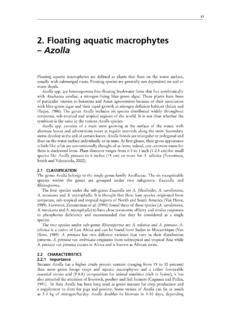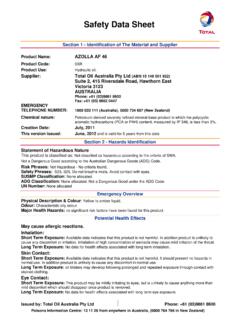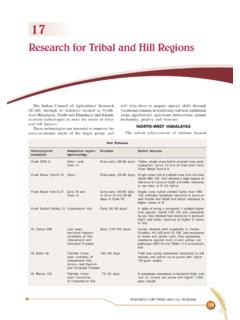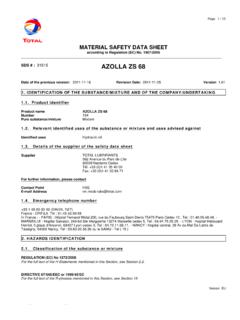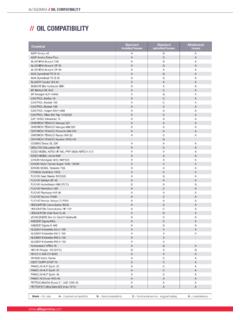Transcription of Taxonomic re-evaluation of the Azolla genus in …
1 Taxonomic re- evaluation of the Azolla genus in PEREIRA, G. TEIXEIRA, I. SEVINATE-PINTO, T. ANTUNES and F. CARRAPI OAzollaLam. is an aquatic fern with deeply bilobedleaves. It has a very thin and hyaline ventral leaf lobe andan aerial and chlorophyllous dorsal lobe, which have anextracellular cavity. Populations of bacteria belonging toseveral genera, and a population of nit rogen-fixingcyanobacteria, Anabaena azollaelive in this cavity(CARRAPI O, 1991; GRILLICAIOLA& FORNI, 1999). Thisassociation is very important as a natural organic fertilis-er for rice production in several countries (LUMPKIN&PLUCKNETT, 1980).Research involving Azollahas often been hindered byconfusion on the taxonomy of the genus . This genus isdivided into two subgenera: Azolla , with two sections Azolla (A. filiculoidesLam., A. rubraR. Br., A. carolini-anaWilld., A. microphyllaKaulf.)
2 , A. mexicanaPresl.)and Rhizosperma(A. pinnataR. Br.) - and subgenusTetrasporocarpia, which only includes A. niloticaDecne(SAUNDERS& FOWLER, 1993). The taxonomy of thegenus Azollais traditionally based on vegetative charac-ters such as plant dimensions, leaf characteristics (shape,papillae and hyaline border of dorsal leaves lobes), andon reproductive characters like the number of massulaeand microsporangia (SVENSON,1944). The number ofglochidia septa in the microsporangium massulae hasbeen used to distinguish between species. This is, how-ever, a variable character, just like the above-mentionedABSTRACT - The Portuguese and the European Flora refer to the presence oftwo or three Azolla species in Portugal: A. filiculoides Lam., A. carolinianaWilld. and/or Azolla mexicana Presl., the latter included in the last edition ofFlora Europaea. In the present work, the taxonomy of Azolla species is reviewedusing the two most important characters that can distinguish between thesetwo/three species: papillae in the dorsal leaf lobe and perine architecture of themegaspore apparatus.
3 Other characteristics, such as the hyaline border cells ofthe dorsal leaf lobes and the number of glochidia septa in microsporangiummassulae, are also used. All the Azolla specimens, collected from severalloc ations in P ort ugal, we re id ent ified as Azolla filicu loides Lam. Thisidentification disagrees with previous published reports on Azolla taxonomy inPortugal as well as with herbarium WORDS - Azolla filiculoides Lam., perine surface, perine zonation,papillae, hyaline border, taxonomyreceived 13 December 2000; revised version accepted 4 June 2001 PLANTBIOSYSTEMS, 135(3) 285-294, 2001vegetative characters. PERKINSet al.(1985) studied theperine architecture of the megaspore of all extant Azollaspecies and found that this characteristic can be used asa distinctive character for interspecific to several authors, in Portugal there are twoor three Azollaspecies belonging to the section Azolla :A.
4 Filiculoides Lam. and A. carolinianaWilld. (ALMEIDA,1986; FRANCO, 1971; LAWALR E, 1964; SAMPAIO, 1990;VASCONCELLOS, 1968) and/or A. mexicanaPresl. (JERMY,1993). In this paper, we revised the vegetative and repro-ductive characters in an attempt to re-evaluate and iden-MATERIALS AND METHODSF resh Azollaspecimens with sporocarps were collectedfrom six different sites in Portugal between 1992 and1998 (Goleg , Nisa, Comporta, Pancas, Adema andGuadiana River) (Table 1). A voucher with the specimeninformation (except for Adema, Pancas, Comporta andNisa) was deposited in LISU. Additional plant materialfrom the following Herbaria was examined: C OI(Herbarium of Faculdade de Ci ncias e Tecnologia daUniversidade de Coimb ra), LISI (Herbarium ofInstituto Superior de Agronomia), LISU (Herbarium ofFaculdade de Ci ncias da Universidade de Lisboa) andP O (H erbarium of Faculdade de C i ncias daUniversidade do Porto) (Table 2).
5 For scanning electron microscopy (SEM), fresh sporo-phytes and sporocarps were fixed in a solution of 3%glutaraldehyde in M sodium cacodylate buffer, , for 2 h at 4 C. After rinsing in the same buffer, thematerial was post-fixed with 2% osmium tetroxideaqueous solution for 1 h, following dehydration in agraded ethanol series, and finally dried with the CO2critical-point method in a Polaron E 3500. All the spec-imens were sputter-coated with gold in a Polaron E5350, observed and photographed at 15-25 kV in JEOL2A. specimens collected in the field between 1992 and 1998 OriginColector nameDateObservationsAdemaF. Carrapi o3/92 ChannelGuadiana riverF. Carrapi o3/93 Bloom in 1993 near M rtola. High density of G. Teixeira, Pereira6/95, 3/96 Lagoon without direct connection to Tejo Azolla were rooted in the Teixeira, Pereira7/97, 4/98 From a marshy site near Tejo river.
6 High in Lisbon Botanical Pereira, G. Teixeira8/97 Collected in rice fields. High in Lisbon Botanical Bastos7/97, 9/97, 3/98 Pool near Ribeira do Figueir .Some Azolla were rooted in the banks. High specimens in Portuguese Herbaria used in this studyHerbariaTaxaOriginCollectorDateLISI -55224A. caroliniana guas de Moura (rice fields)J. Vasconcelos8/55 LISU-P2784A. filiculoidesAlc cer do Sal (rice fields)L. Fernandes5/21 LISU-P2788A. carolinianaPinhal Novo (rice fields)Palhinha4/25 COI-9406A. filiculoidesGeria, Coimbra (pool)A. Fernandes4/65 COI-22/38A. carolinianaPa l da ArzilaMota5/32PO-44133A. filiculoidesTabua o, Adorigo (border of Douro river, quietness)A. Duarte, A. Rozeira9/45PO-4977A. filiculoidesVendas Novas, Casa de Bragan a (fountain)A. Rozeira, J. Alte9/45PO-44132A. filiculoidesField in CoimbraA. Cabral11/20PO-4441A. filiculoidesS. Martinho do Porto (quiet stream)A. Rozeira, J.
7 Castro7/44PO-44134A. carolinianaCoimbra Botanical GardenA. Cabral11/20PO-4214A. carolinianaViseu, D o riverJ. Castro8/44PO-10220A. carolinianaMontemor-o-Velho, Barroca de QuinhentosR. C. Teixeira4/44tify the Azollaspecimens collected in several locations Wetzlar Dialux and Nikon Labophot light well adapted to the Portuguese climate, rang-ing from north to south in some international riverssuch as Douro, Tejo and Guadiana but also in othersnational rivers, lagoons and small pools (Figure 1).Probably because of environmental conditions (espe-cially the warmer climate) it is more frequent in the cen-tre and south of vegetative and reproductive characters wereobserved, but in this study, we only used the charactersdescribed in table 3, which indicate similarities and dif-ferences between the sporophyte of Azollais planar and/or erect depend-ing on environmental conditions and plant density.
8 Thischaracter, in nature, is highly variable and should not beused as a character to distinguish betweenA. filicu-loides,A. carolinianaand A. mexicana. As for the shapeof the sporophyte, it is always number of hyaline border cells and papillae havebeen considered as diagnostic characters to identifyAzollaspecies of the section Azolla . However, all thespecimens collected in the field showed a high variabil-ity in the hyaline border, which consisted of two (Figure2) to four (Figure 3) cell layers. The Herbarium speci-mens of A. carolinianahave two to three cell layers(Figures 4, 5) and those of A. filiculoidesrange from twoto five cell layers (Figures 6, 7). The papillae of dorsallobes from Azollacollected in the field are unicellular, , with only one cell above the epidermal cell (Figure8). The specimen from Pancas, identified as A.
9 Carolini-Herbaria also showed unicellular presence or absence of septa in the anchor-shapemens collected in the field, the number of septa is high-(Figure 13), two or three (Figure 14) even within thesame massula. Herbarium specimens of A. carolinianahave none or one (Figure 15) septum, whereas A. filicu-loides, also from Herbaria, has one (Figure 16) or two(Figure 17) septa in the apex of the glochidia. Theseobservations demonstrate the high variability of thischaracter, that depends on environmental conditions. Itis therefore evident that some vegetative characters andthe number of glochidium septa are not useful for of Azolla in Portugal350 kmFIGURE1 Map of Portugal with the localisation of Azolla filiculoides() and Azolla caroliniana () from Herbaria. It also shows thelocation of field specimens ().JSM 5200Lv and JEOL JSM T220 scanning light microscopy, dried and fresh material wasobserved wit hout st aining and photographed usingana,also has unicellular papillae (Figure 9).
10 Both (Figure 10) and A. caroliniana(Figure 11) fromglochidia has been used to distinguish betweenA. fili-culoides,A. carolinianaand A. mexicana. In the speci-ly variable, varying between none (Figure 12), oneSpecies recognition in the genus Azollashould be basedon differences in the structure of the megaspore appara-tus. The megaspore apparatus of field-collected Azollaalways shows the same perine architecture, including theone from Pancas identified as A. caroliniana. Someherbarium specimens sporulated and were identified A. filiculoides. In all of them, the per-ine surface has distinct raised hexagonal markings tiedby the ends and covered with few filaments (Figures 18,20). In longitudinal section, the perine that surroundsthe megaspore consists of three layers: the innermostexine, an intermediate endoperine and the outermostexoperine.
